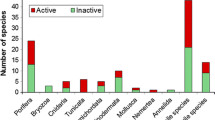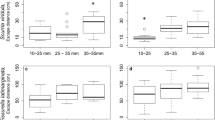Abstract
Postlarval lobsters (4th–7th stage) exclusively fed frozen brine shrimp (Artemia saline) were assayed for food-search response to extracts and metabolites from four common prey: soft clams (Mya arenaria), blue mussels (Mytilus edulis), rock crabs (Cancer irroratus), and sea stars (Asterias vulgaris). Concentrations of soluble primary amines, protein, and ammonia in prey tissues and metabolites were determined. No significant responses were observed for any prey metabolites diluted to 1 and 10%, while onlyA. vulgaris evoked a significant response at full strength, suggesting that predatorily naive lobsters have yet to develop more pronounced chemosensory responses shown by field-collected lobsters. Removal of protein with retention of small-molecular-weight polar molecules did not appear to affect response to prey extracts. EC50s, as micromoles per liter amines, computed from prey extract dose-response curves indicate differences per unit amine between prey extracts, withA. vulgaris extract more potent as an attractant than either bivalve extract.C. irroratus extract was equally attractive as the other three extracts. Ammonia levels excreted into seawater over 3 hr were similar for all prey species, while soluble primary amines and proteins were undetectable. Ammonia and protein per gram whole prey varied significantly between extracts of prey species, while primary amines were similar. Lobsters may be attracted preferentially to carrion species with higher concentrations of amines and/or higher potency of attractants per unit amine.
Similar content being viewed by others
References
Bradford, M.M. 1976. A rapid and sensitive method for quantitation of microgram quantities utilizing the principle of protein dye binding.Anal. Biochem. 72:248–254.
Carr, W.E.S. 1978. Chemoreception in the shrimp, Palaemonetes pugio: The role of amino acids and betaine in the elicitation of a feeding response by extracts.Comp. Biochem. Physiol. 61A:127–131.
Carr, W.E.S., andDerby, C.D. 1986. Behavioral chemoattractants for the shrimp,Palaemonetes pugio: Identification of active components in food extracts and evidence of synergistic mixture interactions.Chem. Senses 11:49–64.
Carr, W.E.S., Netherton, J.C., III, andMilstead, M.L. 1984. Chemoattractants of the shrimp,Palaemonetes pugio: Variability in responsiveness and the stimulatory capacity of mixtures containing amino acids, quaternary ammonium compounds, purines and other substances.Comp. Biochem. Physiol. 77A:469–474.
Carter, J.A., andSteele, D.H. 1982a. Stomach contents of immature lobsters (Homarus americanus) from Placentia Bay, Newfoundland.Can. J. Zool. 60:337–347.
Carter, J.A., andSteele, D.H. 1982b. Attraction to and selection of prey by immature lobsters (Homarus americanus).Can. J. Zool. 60:326–336.
Daniel, P.C., andBayer, R.C. 1986a. Partial purification and characterization of postlarval lobsters (Homarus americanus) feeding attractants from herring (Clupea harengus) tissue.Mar. Behav. Physiol. Submitted.
Daniel, P.C., andBayer, R.C. 1986b. Temporal changes in release rates and quality of lobster (Homarus americanus) feeding attractants from herring (Clupea harengus) baits.Mar. Behav. Physiol. Submitted.
Derby, C.D. 1984. Molecular weight fractions of natural foods that stimulate feeding in crustaceans, with data from the lobsterHomarus americanus.Mar. Behav. Physiol. 10:273–283.
Derby, C.D., andAche, B.W. 1984a. Quality coding of a complex odorant in an invertebrate.J. Neurophysiol. 51:906–924.
Derby, C.D., andAche, B.W. 1984b. Electrophysiological identification of the stimulatory and interactive components of a complex odorant.Chem. Senses 9:201–218.
Derby, C.D., andAtema, J. 1981. Selective improvement in responses to prey odors by the lobster,Homarus americanus, following feeding experience.J. Chem. Ecol. 7:1073–1080.
Derby, C.D., andAtema, J. 1982. Narrow-spectrum chemoreceptor cells in the walking legs of the lobsterHomarus americanus: Taste specialists.J. Comp. Physiol. 146:181–189.
Derby, C.D., Ache, B.W., andKennel, E.W. 1985. Mixture suppression in olfaction: Electro-physiological evaluation of the contribution of peripheral and central neural components.Chem. Senses 10:301–316.
Elner, R.W. 1980. Predation on the sea urchin (Strongylocentrotus droebachiensis) by the American lobster (Homarus americanus) and the rock crab (Cancer irroratus), pp. 48–65,in J.D. Pringle, G.J. Sharp, and J.F. Caddy (eds.). Proceedings of the workshop on the relationship between sea urchin grazing and commercial plant/animal harvesting.Can. Tech. Rep., Fish. Aquat. Sci. 954.
Elner, R.W., andJamieson, G.S. 1979. Predation of sea scallops,Placopecten magellanicus, by the rock crab,Cancer irroratus, and the American lobster,Homarus americanus.J. Fish. Res. Board Can. 36:537–543.
Ennis, G.P. 1973. Food, feeding, and condition of lobsters,Homarus americanus, throughout the seasonal cycle in Bonavista Bay, Newfoundland.J. Fish. Res. Board Can. 30:1905–1909.
Evans, P.D., andMann, K.H. 1977. Selection of prey by American lobsters (Homarus americanus) when offered a choice between sea urchins and crabs.J. Fish. Res. Board Can. 34:2203–2207.
Herrick, F.H. 1985. The American lobster: A study of its habits and development.Bull. U.S. Fish. Comm. 15:1–252.
Hirtle, R.W.M., andMann, K.H. 1978. Distance chemoreception and vision in the selection of prey by American lobster (Homarus americanus).J. Fish. Res. Board Can. 35:1006–1008.
Johnson, B.R., andAtema, J. 1983. Narrow-spectrum cells in the antennules of the American lobster,Homarus americanus.Neurosci. Lett. 41:145–150.
Leavitt, D.F., Bayer, R.C., Gallagher, M.L., andRittenberg, J.H. 1979. Dietary intake and nutritional characteristics in wild American lobsters (Homarus americanus).J. Fish. Res. Board Can. 36:965–969.
Lindroth, P., andMopper, K. 1979. High-performance liquid chromatographic determination of subpicomole amounts of amino acids by precolumn fluorescence derivatization witho-phthal-dialdehyde.Anal. Chem. 51:1667–1674.
Mackie, A.M. 1973. The chemical basis of food detection in the lobsterHomarus gammarus.Mar. Biol. 21:103–108.
McLeese, D.W. 1970. Detection of dissolved substances by the American lobster (Homarus americanus) and olfactory attraction between lobsters.J. Fish. Res. Board Can. 27:1371–1378.
McLeese, D.W. 1973a. Olfactory responses of lobsters (Homarus americanus) to solutions from prey species and to seawater extracts and chemical fractions of fish muscle and effects of antennule ablation.Mar. Behav. Physiol. 2:237–249.
McLeese, D.W. 1973b. Orientation of lobsters (Homarus americanus) to odor.J. Fish. Res. Board Can. 30:838–840.
Miller, R.J.K., Mann, K.H., andScarratt, D.J., 1971. Production potential of a seaweed-lobster community in eastern Canada.J. Fish. Res. Board Can. 28:1733–1738.
Rittschof, D. 1980. Enzymatic production of small molecules attracting hermit crabs to simulated gastropod predation sites.J. Chem. Ecol: 6:665–675.
Rittschof, D., Shepherd, R., andWilliams, L.G. 1984. Concentration and preliminary characterization of a chemical attractant of the oyster drill,Urosalpinx cinerea.J. Chem. Ecol. 10:63–79.
Rittschof, D., Forward, R.B., andMott, D.D. 1985. Larval release in the crabRhithropanopeus herrisii (Gould): Chemical cues from hatching eggs.Chem. Senses 10:567–577.
Roth, M. 1971. Fluorescence reaction for amino acids.Anal. Chem. 43:880–882.
Scarratt, D.J. 1980. The food of lobsters, pp. 66–91,in J.D. Pringle, G.J. Sharp, and J.F. Caddy (eds.) Proceedings of the workshop on the relationship between sea urchin grazing and commercial plant/animal harvesting.Can. Tech. Rep., Fish. Aquat. Sci. 954.
Sokal, R.R., andRohlf, F.J. 1981. Biometry: The Principle and Practice of Statistics in Biological Research. W.H. Freeman, San Francisco, 859 pp.
Solorzano, L. 1969. Determination of ammonia in natural water by the hypochlorite method.Limnol. Ocean. 14:799–801.
Squires, H.J. 1970. Lobster (Homarus americanus) fishery and ecology in Port au Port Bay, Newfoundland, 1960–65.Proc. Natl. Shellfish. Assoc. 60:22–39.
Squires, H.J., andEnnis, G.P. 1968. Lobsters from 95 fathoms deep off St. John's, Newfoundland.J. Fish. Res. Board Can. 25:2723–2724.
Zimmer-Faust, R.K., andCase, J.F. 1982. Odors influencing foraging behavior of the California spiny lobster,Panulirus interruptus, and other decapod Crustacea.Mar. Behav. Physiol 9:35–38.
Zimmer-Faust, R.K., Tyre, J.E., Michel, W.C., andCase, J.F. 1984a. Chemical mediation of appetitive feeding and synergism.Biol. Bull. 167:339–353.
Zimmer-Faust, R.K., Tyre, J.E., Michel, W.C., andCase, J.F. 1984b. Chemical induction of feeding in the California spiny lobster,Panulirus interruptus (Randall): Response to molecular weight fractions of abalone.J. Chem. Ecol. 10:957–970.
Author information
Authors and Affiliations
Rights and permissions
About this article
Cite this article
Daniel, P.C., Bayer, R.C. Attraction of predatorily naive postlarval lobsters to extracts of metabolites of common prey:Mytilus edulis, Mya arenaria, Cancer irroratus, andAsterias vulgaris . J Chem Ecol 13, 1201–1215 (1987). https://doi.org/10.1007/BF01020549
Received:
Accepted:
Issue Date:
DOI: https://doi.org/10.1007/BF01020549




